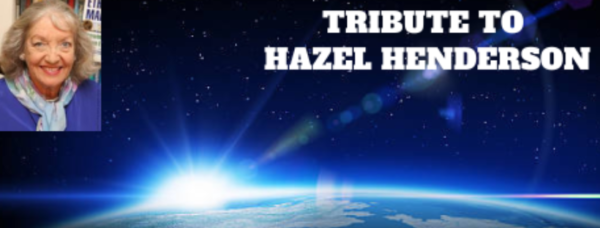SYNDICATED DISTRIBUTION TO 400 NEWSPAPERS IN ASIA, EUROPE, LATIN AMERICA, AND AFRICA IN 27 LANGUAGES. For information on subscribing to INTERPRESS SERVICE (IPS) Rome, contact: Pablo Pacientini, fax: 039-6-481-7877. For permission to syndicate or reprint, contact: Teddy Jefferson (IPS) New York, phone: 1-212-924-9102; fax 1-212-924-9120.
For InterPress Service
© Hazel Henderson, 1998
(word count 851)
RULES TO TAME THE GLOBAL CASINO
The current globalization of the Asian economic crises is, at last, calling forth some policy responses. The Asia “flu” spread to Russia, East Europe, Latin America and began threatening prosperity in Europe and North America amid rolling currencies and stock markets. President Bill Clinton began in mid-September to echo proposals for taming the global casino heard since the 1995 UN Social Summit in Copenhagen. Today’s global financial non-system – produced by electronic communication technologies and the triumph of market deregulation and privatization begun in the 1980’s — is showing weakness and unsustainability. The see-saw struggles of the past decade between unregulated market forces and the role of governments — and their respective responsibilities to their citizens –are now on the global agenda. The first casualty of today’s economy crises has been traditional economic prescriptions for wealth and progress, via GNP-measured, export-led growth, opening domestic markets, deregulation, privatization and widening trade. All this was equated with the spread of democracy. Often summed up as “the Washington Consensus” these prescriptions have been pushed by US business and government leaders, the World Bank and the IMF — all based on 19th century economic testbooks. President Clinton openly called for re-writing these economic texts to deal with today’s globalized finance and markets. He pointed out that “poor and vulnerable people affected by these global markets should not have to be sacrificed to economic theories”. Clinton called for reforming the IMF which has made Asia’s crises worse.
But Clinton as short on specifics, calling for a meeting to be convened in Washington of
central bankers and finance ministers to “promote global growth, write-down debt, replenish the IMF and continue opening markets” — all familiar nostrums. Some new initiatives were hinted:
| Get the World Trade Organization (WTO) to open up to scrutiny by consumers, employees and citizens impacted adversely by narrow trade pacts — and to consider the environment. | |
| Begin to implement the vague calls by Treasury Secretary Robert Rubin, Federal Reserve Chairman Alan Greenspan for “a new financial architecture” to buttress world markets. |
What is needed is nothing short of a “New Bretton Woods” the international conference which in 1944, created the first global architecture. These multilateral rules and agencies, including the World Bank and the IMF, served the world economy until 1971 when US President Nixon unilaterally pulled the plug by slamming the US gold window shut. Since then, the world has lurched from crisis to crisis – through a roller coaster of global recessions, currency gyrations, and many ad hoc arrangements for floating currencies, capital movement controls and convertibility rules. Today’s growth of financial flows: daily $1.5 trillion global tides which slosh back and forth — create asset bubbles on Wall Street and currency meltdowns in Asia. Huge lossses, collapses of banks and brokerages resulted — as volatility and volumes grew.
Investors began hedging their holdings by buying future contracts “derivatives” — betting on which way interest rates and currencies would move. Today, there are between $30-50
trillion in such derivative positions — where each player hedges their individual risk by adding such risks to the whole global system.
Back in 1995, at Copenhagen a set of proposals emerged in the report of the Global Commission to Fund the United Nations (which this author co-edited). We called for:
| A very small (0.05%) tax on all currency trades, first discussed at Bretton Woods in 1944 and later versions proposed by US economists James Tobin (in 1975) and by Lawrence Summers, now Under Secretary of the Treasury, in 1989. Such a tax would not hurt real, long-term investors, but would bite speculators who move money across borders often hundreds of times a day. | |
| A global version of the US Securities and Exchange Commission (SEC) to harmonize regulations of securities and currency markets. Such an international supervisory body would curb today’s unregulated global casino of insider trading, fraud, money-laundering and capital flight. Today, speculators’ “bear raids” attack perceived weak currencies such as those in 1993 which drove the British pound down and out of the European Monetary Union (EMU). | |
| A proposal that the world’s major central banks get together and set up their own “public utility” currency exchange. Thus they could compete with today’s money center banks and speculators and properly oversee their currencies to protect their domestic purposes. |
Clearly, it is time for a new Bretton Woods conference — convened by the United Nations — to redesign the world’s financial architecture and at last, cooperatively write new rules needed to tame the global casino.
*****
Hazel Henderson is author of Building a Win-Win World (1996, 1997), co-editor of The UN: Policy and Financing Alternatives, the report of the Global Commission to Fund The United Nations. (1995, 1996) Review copies obtainable by fax 904-826-0325 (USA).
